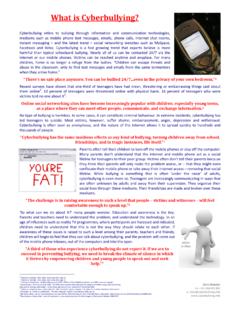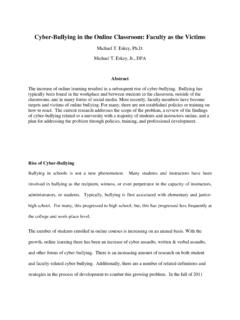Transcription of Model Policy to ddress Bllyi - VDOE :: Virginia …
1 Model Policy to Address bullying . in Virginia 's Public Schools Virginia Board of Education October 2013. Model Policy to Address bullying in Virginia 's Schools Board of Education Commonwealth of Virginia October 2013. Acknowledgements Dr. Patricia I. Wright Superintendent of Public Instruction Virginia Department of Education Mr. John Eisenberg Assistant Superintendent, Division of Special Education and Student Services Virginia Department of Education Dr. Cynthia A. Cave Director, Office of Student Services Virginia Department of Education Dr. Michelle Schmitt, Director Center for School-Community Collaboration School of Education Virginia Commonwealth University Dr.
2 Wayne Barry Student Services Specialist Virginia Department of Education Ms. JoAnn Burkholder Student Assistance Systems Coordinator Virginia Department of Education Please direct any questions about this Model Policy to: Dr. Cynthia A. Cave Or Ms. JoAnn Burkholder The Department expresses its deepest appreciation to all professionals who reviewed and offered comment on this Model Policy prior to its publication, especially Dr. Catherine Bradshaw of Johns Hopkins University and the University of Virginia . i TABLE OF CONTENTS. Introduction .. 1. Defining bullying Behavior bullying .. 2. Cyberbullying .. 4. 4.
3 bullying and Harassment Prohibited .. 5. Aggressor/Bully .. 5. Bystanders .. 5. Retaliation .. 5. Staff .. 5. Target (Victim) .. 5. Prevention and Intervention Evidence-based prevention programs expected .. 6. School climate encourages reporting bullying .. 6. Collaboration with families/communities .. 6. bullying prevention coordinator in school 6. Information dissemination .. 7. Education .. 7. Training .. 7. Conducting school safety 7. Reporting, Investigating and Recording Incidents Reporting an incident of bullying .. 8. 8. Reporting investigation results .. 10. Additional considerations .. 10. School division recordkeeping and review.
4 11. Considerations for students with disabilities .. 11. Notification Right(s) to other legal recourse .. 12. Relationship to other 13. Procedure for referring affected parties for counseling .. 13. Appendix A Sample School Board Policy Regarding Anti- bullying .. 15. Appendix B 2010 Dear Colleague Letter .. 16. Appendix C 2013 Dear Colleague Letter and Enclosure .. 25. Appendix D bullying Incident Report Form (Sample).. 36. Investigation Form (Sample) .. 37. Follow-Up to the Investigation Form (Sample) .. 39. References .. 40. ii Research consistently demonstrates that a strong, proactive stance against aggression and bullying behavior is the best means of discouraging bullying in school settings; however, nothing replaces teaching and reinforcing positive and socially accepted behaviors in children.
5 Introduction bullying is a problem in many spheres of our culture: it exists in the work place, it exists in intimate relationships, and it exists in families and communities. bullying exists in public schools but public schools are in a unique position to educate children and adolescents about its presence, danger, and negative consequences. Schools can also teach behaviors that will protect students from the harmful effects of bullying . Based on the findings of past and current research, this Model Policy promotes school practices that address bullying behaviors in This document provides the Code of Virginia 's definition of bullying established in This Model Policy unequivocally considers bullying , aggression, and harassment as unacceptable behaviors; it promotes adoption of age-appropriate strategies designed for prevention, intervention, and accountability for bullying behaviors; and it promotes the use of whole-school and evidence- based practices in the classroom, in the school, and across the school division.
6 Virginia school boards have been required to include bullying prevention as a part of character education since 2005 ( of the Code of Virginia ). In addition, school boards are expected to include bullying as a prohibited behavior in their student codes of conduct ( of the Code of Virginia ) and to implement policies and procedures to educate school board employees about bullying and the need to create a bully-free environment ( of the Code of Virginia ) by July 1, 2014. The Virginia General Assembly's House Joint Resolution 625 (2011) required the Virginia Department of Education (VDOE) to study local school divisions' antibullying policies.
7 This current Model Policy is an outgrowth of that study, and is designed to guide every school division in the development, promotion, and implementation of policies prohibiting bullying . In order to best address local conditions, such Policy should be developed, promoted, and implemented through a collaborative process that includes all interested stakeholders: school administrators, school educators and staff, students, families, and the community-at-large. HB1871 enacted by the 2013 General Assembly required the Virginia Board of Education to develop by January 1, 2014, Model policies and procedures for use by each school board regarding the prevention of bullying in their schools.
8 bullying has been linked to negative outcomes for students who are its victims, for bystanders, and for students who are bullies themselves. bullying negatively affects school climate. bullying also has negative impacts on learning, health, behavior and school outcomes. For these reasons, every school division should be committed to providing a safe and civil environment for all students, employees, parents or guardians, volunteers, and visitors. Every school division should adopt policies that indicate bullying is not acceptable and that it will be met with consequences that are developmentally appropriate and sensitive to context.
9 1 Words and phrases in italics signify core facets and elements for school divisions to consider including in their policies, non-italicized words and phrases provide introduction, clarification, and deeper understanding of the italicized text. 1. A basic assumption of this Model Policy is that schools and school divisions will mobilize the energies within the school community and the community-at-large to promote and facilitate the reporting of suspected bullying incidents, to investigate all incidents thoroughly, and to use the resulting data to bolster and improve bullying reduction and prevention efforts.
10 The Model Policy promotes the practices of educating students about bullying and its prevention, training staff in proactive ways to prevent and intervene in bullying situations, and maintaining a clearly defined investigation protocol overseen by a trained coordinator. Included in the appendices is a letter from United States Department of Education's Office of Civil Rights advising school leaders that some instances of bullying could constitute a violation of an individual's civil rights. Research shows that a comprehensive approach to bullying in schools includes the following ten components: (1) A clear definition of bullying ; (2) utilization of effective evidence-based program(s); (3) staff communication and training (annually); (4) feedback from teachers and other school staff; (5) student education (annually); (6) student surveys; (7) parent communication, education and surveys; (8) intervention(s) with victim; (9) intervention(s) with a student(s) who bullies(y); and (10) evaluation of prevention and intervention efforts.
















